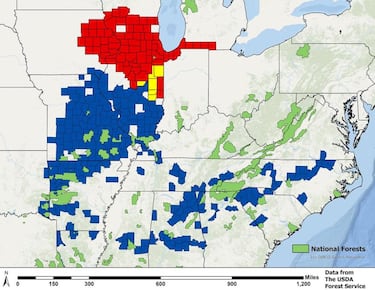2024 Cicada map in the United States: Where are Broods XIII and XIX predicted to emerge?
Cicadas have already begun to make their way out of the ground, as this year two broods will be emerging. Here are the areas which will see them the most.

Cicadas, those loud-buzzing insects that emerge from the ground during certain cyclical periods, are coming out in the trillions in the United States this spring.
One of the most remarkable aspects of these insects is their synchronized emergence, known as a “brood.” Different broods of cicadas emerge in specific geographic regions at regular intervals, often every 13 or 17 years, depending on the species.
This periodic appearance is thought to be an adaptation that helps cicadas avoid predation and increase their chances of successful reproduction.
Cicadas have a unique life cycle that typically spans several years. Most species spend most of their lives underground as nymphs, feeding on plant roots. After several years, the nymphs emerge from the ground in large numbers, undergo a final molt, and transform into winged adults. Due to warm soil and conducive conditions this spring, the flying insects are already swarming 17 states.
READ ALSO: Boeing’s Starliner first manned launch given the “go”
Thinking about joining the cicadas this summer and just screaming for six weeks straight. You? pic.twitter.com/snKr0BTJWk
— National Park Service (@NatlParkService) May 8, 2024
2024 Cicada map in the United States: Where are Broods XIII and XIX predicted to emerge?
Both the 13-year and the 17-year broods are coming out of the ground, arriving in parts of the U.S. in numbers that the country has not witnessed in decades. These areas are now being subjected to loud, buzzing calls, which males produce to attract females during the mating season.
The 13-year insects are called Brood XIX, also known as the Great Southern Brood, while the 17-year cicadas are called Brood XIII, or the Northern Illinois Brood. As the name suggests, the insects will emerge in Illinois.
This USDA Forest Service map shows the brood emergence from April to May 2024 in eastern parts of the country. The areas marked in blue represent where 13-year Brood XIX is expected to emerge, the ones in red represent Brood XII, the 17-year brood. The areas colored yellow are where the two broods are expected to overlap in Illinois.

Meanwhile, Mount St. Joseph University in Cincinnati, Ohio, has developed a tracker for the buzzing insects called Cicada Safari. The program provides a map that also shows where the cicadas are expected to come out.
According to the tracking app, the insects are already out in full force in the following states:
| BROOD XIX | BROOD XIII |
|---|---|
| Alabama | Illinois |
| Arkansas | Indiana |
| Georgia | Iowa |
| Illinois | Wisconsin |
| Kentucky | |
| Maryland | |
| Mississippi | |
| Missouri | |
| North Carolina | |
| Oklahoma | |
| South Carolina | |
| Tennessee | |
| Virginia |
What are the differences between brood XIX and brood XIII cicadas?
Cicadas are generally divided into two groups, annual and periodical. While the annuals emerge throughout the summer from their burrows after spending two to five years, sometimes more, underground, the 15 groups of active periodicals like to come out en masse, and turn up the volume.
The Great Southern Brood
The largest of the three 13-year periodical cicada broods by geographically extent, Brood XIX, also known as ‘The Great Southern Brood’, began emerging in late-April. It is made up of four separate species of cicadas according to the University of Connecticut.
13-year cicada broods generally have their geographical territorial range in the south. But brood XIX also has a solid presence across Missouri as well as southern and central Illinois.
In 2024, members of brood XIX in central Illinois will be co-mingling with members of brood XIII. This group of cicadas comes out once every 17 years and the last time the two broods were together was in 1803, when Thomas Jefferson was the US president.
READ ALSO: “Better memory” among various benefits claimed from drinking this tea
The Northern Illinois Brood
Brood XIII, also known as ‘The Northern Illinois Brood’, is made up of three other species of cicadas. It has “one of the largest and best documented off-cycle or ‘straggling’ emergence[s]” according to the University of Connecticut.
While the two broods may consist of seven different species of cicadas, they will be making a similar racket like no other and it will be impossible to distinguish between one or another. Likewise, the appearance of periodical cicadas is similar as well.
Periodical cicadas in general have black backs, orange undersides, red eyes and are just over an inch in length. Their wings are clear and membranous with black veins with a span of roughly three inches.
The effect of cicadas
While there may be anywhere from 50,000 to 1.5 million of the critters per single square acre, there is no need to worry about most of your plants nor your body. Except for giving many the creepy crawlies, the noisy revelers don’t bite humans or animals as they are herbivores.
Related stories
As for your trees and plants, they don’t eat vegetation and generally don’t irreparably damage trees. They suck on the juices in trees and make slits in branches to lay their eggs, but excessive numbers may overwhelm young trees, which can be protected by shrouding them in a net.
The thunderous noise the cicadas produce is pretty much the most harm they can cause humans.


Complete your personal details to comment